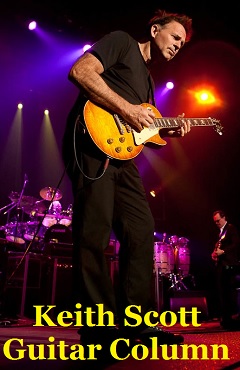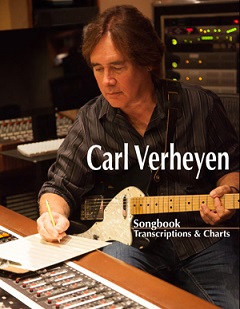Steve Smith

Steve Smith is a legendary drummer best known for his work with the iconic American rock band Journey, whose timeless hits—like “Don’t Stop Believin’,” “Open Arms,” and “Separate Ways”—remain beloved by fans around the world, including in Japan. Smith’s dynamic fusion of rock and jazz rhythms and his exceptional technical prowess have left a lasting mark on Journey’s most celebrated recordings. But his talents extend far beyond that—he’s also made a name for himself through acclaimed projects like Vital Information and Steps Ahead, where his drumming continues to shine with unmatched precision and creativity.
On New Perspective, the latest album from Steve Smith & Vital Information, released in 2025, Smith revisits Journey classics such as “Don’t Stop Believin’,” “Open Arms,” and “Who’s Crying Now” through a bold and imaginative jazz-rock lens, breathing new life into these familiar songs. His rhythmic mastery captivates once again, blending innovation with deep musicality.
This time, Japanese drummer Shun Minari—known for his work with the rock band BLINDMAN, as well as his performances on numerous anime soundtracks and with a wide range of Japanese artists—posed a series of questions to Steve Smith. Their exchange dives into the making of New Perspective, offering insight into the creative process and rhythmic concepts behind the record—from one drummer to another.
Interview Shun Minari
Translation Hiroshi Takakura
Shun Minari : I would like to ask about your latest release, New Perspective. Your previous album featured a cover of “Self Portrait” and this time, alongside Steps Ahead tracks, you’ve boldly
reinterpreted Journey songs, a significant part of your own musical legacy, through a jazz (jazz-rock) lens. Looking back on your career through a different project feels like a surprising yet bold decision. What led to the making of this album?
Steve Smith : The new members of Vital Information, Janek Gwizdala on bass and Manuel Valera on
keyboards, came up with the idea of playing new arrangements of Journey music. I was not
convinced it was a good idea until we played the arrangements they came up with; I loved
them! The jazz interpretations are nothing like the original recordings and they fit the jazz-rock concept of Vital Information perfectly. That led to more new arrangements. First, a Steps Ahead tune they love, which I had played with that group, “Sumo” by Michael Brecker. Then some earlier music of Vital Information, “The Perfect Date,” “Eight+Five,” and “Charukeshi Express”.
SM : Listening to the album, not only can we enjoy each member’s incredible approach and stimulating improvisations, but the arrangements also seem to integrate Journey’s music seamlessly into everyday life in a more refined and natural way.
SS : Agreed. I never would have imagined that the Journey songs would work so well as jazz-
rock pieces.
SM : The recording sessions for "Don't Stop Believin’" and "The Perfect Date" have been shared
on YouTube—are these the actual takes used on the album? With "Vital Information," what’s
the usual process from conceptualizing a song to recording? Do you start with demo tracks,
written scores, or is it more about refining the music through repeated sessions?
SS : The videos that you see online are us recording the music in the studio. They are the takes used on the New Perspective album. We play the music “live” in the studio with only an occasional overdub to enhance certain sections. The videos from the 2022 albums Time
Flies and A Prayer For The Generations are also posted online. Again, these are the actual takes that are on the recordings. With the rearrangement of tunes we start with a chart and then start to get into details at rehearsals.
SM : Would you describe “Charukeshi Express” as drum scat? The concept was truly innovative and inspiring. Heart of the City has been re-recorded, and the new section in the scat portion, along with the double bass unison while keeping the groove, almost feels like a heavy metal approach, despite the difference in sound! Do you regularly listen to or check out music outside of the genres you’re most familiar with?
SS : “Charukeshi Express” started as a drumset and Konnakol solo piece. Konnakol is the south Indian vocal artform of reciting rhythms using specific syllables. It’s not improvised like “scat.” I perform a number of these type of compositions when I do Masterclasses or Clinics. I chose a tempo and groove and then recite fixed Konnakol compositions over the groove. The idea comes from the Carnatic music of south India but I have made it my own by applying the concept to the drumset. The melodic parts for that song were composed by saxophonist George Brooks. We did record that song on the Heart Of The City album but the new Vital Information has transcended that version and we added a “double bass drum” part!
SM : Tell us about the drum kit used on this album. Do you switch between different kits, snares, and cymbals depending on the song within a single album?
SS : The first four songs were recorded with my Sonor 30th Anniversary kit that I’ve had since 2007, which was the 30th Anniversary of me playing Sonor drums. I used the same kit and cymbals on the Time Flies album and A Prayer For The Generations. The kit has a 20×16 bass drum, 14×5.5 metal snare, 14×5 ¾ wood snare, 12×5 snare. The toms are 8×8, 10×8, 12×8, 14×14, 16×16, 18×16. The Zildjian 22” main ride is called a “Left-Side Ride,” the ride to my left is a 21” “Staccato Ride,” and the ride to my far right is a 20” mini-bell prototype. I did make a few changes on songs 5-9 on the New Perspective album. I used the same kit with my 18×16 bass drum, for the main snare I used a Jeff Ocheltree 14×5 that I’ve had for 20+ years that is quite similar to my 30 th Anniversary snare drum. I changed the main ride to a 22” custom-made Zildjian ride that is a copy of one of my old K Zildjian cymbals.
SM : Many tracks on this album feature dramatic drum solos. This might be a rather abstract and instinctive question, but what goes through your mind when you transition from keeping the beat to soloing? How does your perspective shift in those moments, and what kind of imagery guides you as you construct and develop your solos in real-time?
SS : When I play solo within a song, I am still keeping a beat and thinking of my role as the
drummer providing a foundation for the group. My vocabulary for soloing has been developing for many years which gives me many options of what to play during solos. My process is to put myself in a state of flow and allow my rhythm and melodic ideas to come forward without much of a mental filter. I usually have some kind of an arc where the solo has a beginning, middle and ending that makes sense in context of the tune.
SM : “Open Arms” and “Who’s Crying Now” have bold new arrangements, yet the way the
simple beats and dynamic shifts create drama within the songs remains unchanged from the
originals. Do you feel that these songs naturally lead you in that direction when playing them?
SS : “Open Arms” has drumming that is similar to the original version. “Who’s Crying Now” is
very different from the original. Most of the tune is in 15/8 and the rhythmic framework that is
in 4/4 is unpredictable. I follow the inspiration of the new arrangements and not the ideas
from the originals.
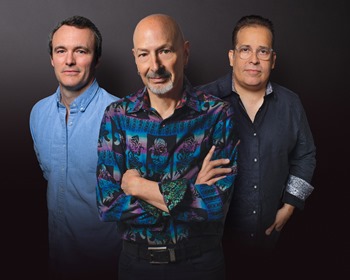
SM : “Three Of A Kind” has a relaxed session-like feel, with plenty of moments where you and the other musicians challenge each other. How would you describe Manuel Valera and Janek Gwizdala as players from your perspective?
SS : Both Manuel and Janek have deep knowledge of jazz repertoire and canon. Their time, feel and musicianship is of the highest caliber. They are also incredible improvisers and virtuosos. This makes them ideal musicians for me to make music with.
SM : Just the other day, I had the chance to cover “Beirut” by Steps Ahead as part of a session gig setlist. Listening to the live recording materials, I felt an intense rock spirit in the performance. You’ve been very active in jazz in recent years, but despite jazz and rock being vastly different genres (though perhaps “different” isn’t quite the right word), I’ve always felt that your drumming sings in both contexts.
SS : My drumming encompasses what I refer to as U.S. Drumming. I came up playing the music of the USA which makes me comfortable playing jazz, rock, R&B, country or genre that originated in the U.S. When I was first playing the drums in the 1960s there wasn’t a large division between jazz and rock, that gap has gotten wider over the years. Most musicians that played on early rock albums were coming from jazz. And young jazz players of that time were comfortable with rock, which led to jazz-rock.
SM : If you could share some advice with all drummers out there, what would it be? Any key insights specific to recording and live performance?
SS : Be sure you have a strong foundation in the fundamentals of playing the drumset. The
only way you become a developed musician is to play many gigs and be involved in recording sessions. Learn how to be a good collaborator and contributor by taking opportunities that come your way. Stay active and play as much as possible.
SM : What are your upcoming plans? It’s been a while since “Vital Information” last toured Japan, and I know many fans are eagerly awaiting your return!
SS : We all love performing in Japan and hope to come there soon!
SM : I hope we’ll have the opportunity to meet in Japan someday!
SS : Yes, I too look forward to meeting in Japan!
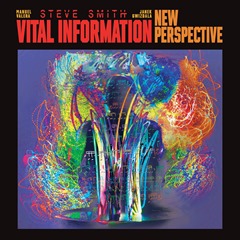
Steve Smith & Vital Information / New Perspective
1. Don’t Stop Believin’
2. The Perfect Date
3. Charukeshi Express
4. Open Arms
5. Sumo
6. Eight + Five
7. Who’s Crying Now
8. Three of a Kind
9. Josef The Alchemist
Steve Smith – drums
Manuel Valera – keyboards
Janek Gwizdala – bass
https://vitalinformation.com/store/
– Interviewer: Shun Minari –
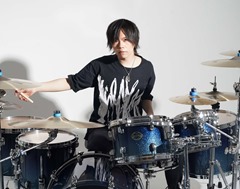
Born on June 27 in Osaka Prefecture. While studying at university, he studied under drummer Koji Hasegawa. After engaging in band activities, he moved to Tokyo and joined the rock band BLINDMAN. Discovered by composer/keyboardist Yasuharu Takanashi, he became a member of Takanashi’s group Yaiba, contributing to numerous anime soundtracks including FAIRY TAIL, Naruto: Shippuden, BORUTO: Naruto Next Generations, the Pretty Cure series, Record of Ragnarok, Hell Girl, and Kinnikuman: The Superhuman Origin Arc. The group now regularly embarks on world tours during the summer.
In addition to this, he has performed in live shows and recording sessions with artists such as Ruriko Kuboh, ReiRi, Natsuki Hanae, Kenjiro Tsuda, Ayane Sakura, Akari Kito, and Yoshino Nanjo.
Currently, he remains active across a wide range of musical fields, including session performances, interviews, and musical score supervision, regardless of genre.
Shun Minari official site : https://www.shun-minari.com/
